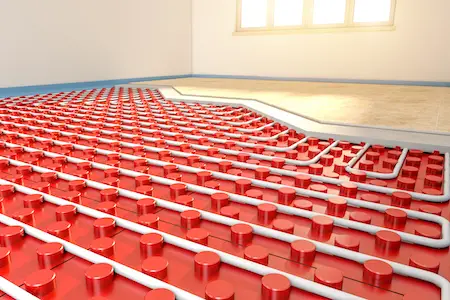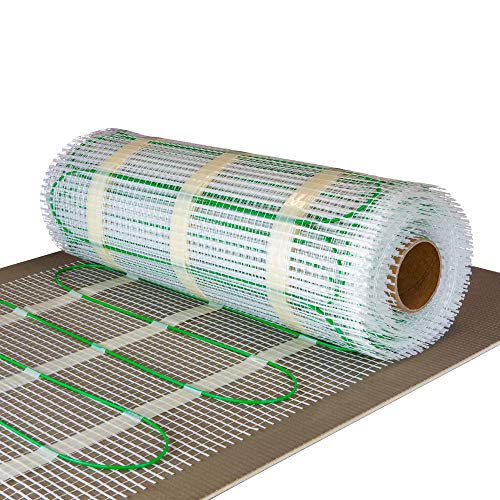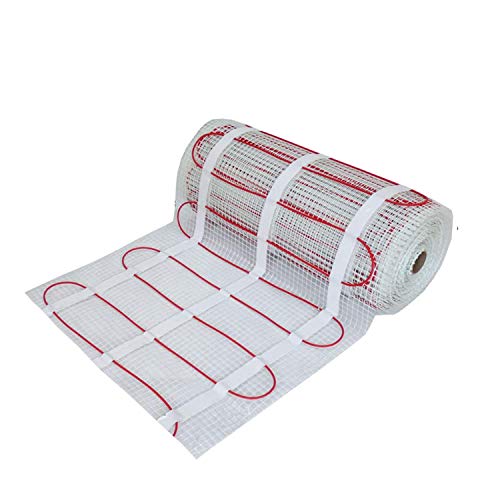Heated floors or commonly known as radiant floors come in two different heating types. These types are dry or also known as ‘electric’ and water systems. However, each heating type provides similar results. A radiant floor system heats the room from the floor and rather than a normal radiator which heats the room from the side.

It is widely recognised that warm floors with underfloor heating tend to heat the entire room more effectively than standard radiators, as they’ll heat the centre of the room much quicker.
Let’s start with how electric heated floors work, they normally come in carpet-like rolls and come in both ‘mat’ form and ‘foil’ depending on what’s needed on your floor type. These include a super-tin heating wire which once connected to the mains, will get hot through electricity and provide radiant heat.
Typically, people would use this type of heated floor system if you were installing it on an already built house. This is because it doesn’t require much room under your floors, and you may not have to raise them. If not, the floors can be pulled up and the electric heating can be placed down.
Next are water systems, as you can probably tell from the name it produces radiant heat through heated water. They’ll be laid under your floor in a zigzag or ‘s’ shape pattern, this is the best way to distribute the heated areas. Unlike electric heated floors, this type of heating is normally installed before the flooring has been laid in a house.
This is because the pipes need room underneath your floorboards to breathe and are around 3 to 4 inches wide. But it is not impossible to get these installed into an already built house, it’ll just require a bit of know-how, time and money.
Benefits of Heated Floors
Now that you have a better idea of how heated floors work, what types of underfloor heating systems exist and what types of heating they provide.
Let’s now discuss what benefits they provide
Both types of heated floors provide a stable and consistent efficiency of heat. Instead of your standard wall radiators, which heat the side of a room. A heated floor will heat the room evenly resulting in the room warming up quicker and may even be more efficient due to not needing as much heat to warm the entire room.
Eliminating your standard radiator system will give you more design freedom and space. I’ve been in this position myself and I’m sure you have to, but when your designing or organizing a room it can be super frustrating having to work around the radiator as you don’t want to cover it. Taking these out and having heated floors, allows you to organize the room the way you want to without any radiators getting in the way.
Lastly, you certainly won’t be restricted in which floor covering you want due to having heated floors. Heated floors work on most flooring material including laminate, wood, carpet, stone, and tiles.
Negatives of Heated Floors
Like most thing which we can benefit from, there is always negatives. But what are the negatives to having heated floors installed in your house?
Heated floors are an investment and can be extremely expensive. These prices depend on where you live but it’s been estimated that most heated floor systems cost around $10-20 per square foot. However, you’ll earn your money back which you’ve invested as it’ll increase your house’s value and your heating will be more efficient.
If you haven’t already got heated floors and you want to go for a wet heated floor system. Then your floors will probably have to be raised, I can’t tell you by how much as the amount will change from house to house. Either way, if you want a wet system your floors will have to be ripped up then replaced again. This can be rather expensive and time-consuming.
Flowing from time-consuming, the installation time could take a while depending on your floor’s fundamentals. Most electric heated floor systems need to sit on a self-levelling compound and will take a few days to dry before you even think about re-laying the floor again.
Are Heated Floors Worth It?
The question we all want to know, but in all honestly it really does depend on your situation. If you have the capital and want to invest it into your home for more efficient heating, then it’s totally worth it and you’ll also increase your property value.
I’d also consider adding heated floors if I’m already renovating a room. If your re-doing your bathroom or kitchen and you decide to change the flooring, I would consider adding heated flooring before re-laying my new one.

At the end of the day, it’s expensive but it can certainly save you a ton of money in the long run and ultimately increase the value of your house. Assess your situation and evaluate it on how much money and work you’ll have to put into installing heated floors and go from there.
Is It Easy to Add Heated Floors to an Already Built House?
A common question that is asked, and I totally understand why. It can be expensive to add heated floors to an already built house. However, this can vary from house to house and depends on your property’s foundations. If for whatever reason you didn’t need to raise your floors because there’s enough room under the sub-floor, then it shouldn’t cost much more than the original square footage price and should be fairly easy to fit.
If you wanting to install a wet system, then I’d ask your boiler provider if it’ll be compatible with heated floors and you may need to get a more powerful one. Hopefully, you won’t need to get a newer boiler. But if installing wet heated floors require you to, I recommend having a look at getting the electric heaters installed instead.
It may seem hard, but it’ll be worth every bit of money and you’ll end up getting your money back from your property value or the money you’ll be saving on your house being more energy-efficient.




